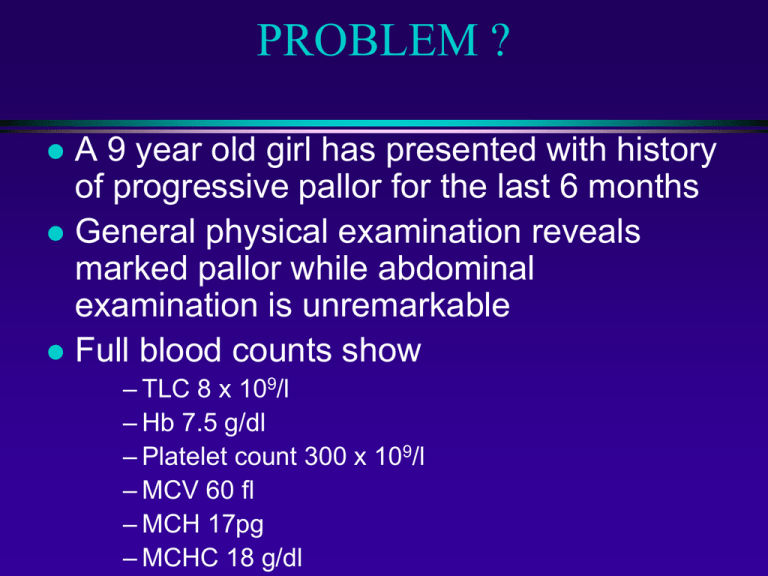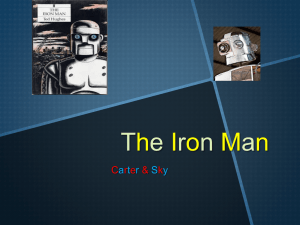
PROBLEM ?
A 9 year old girl has presented with history
of progressive pallor for the last 6 months
General physical examination reveals
marked pallor while abdominal
examination is unremarkable
Full blood counts show
– TLC 8 x 109/l
– Hb 7.5 g/dl
– Platelet count 300 x 109/l
– MCV 60 fl
– MCH 17pg
– MCHC 18 g/dl
PROBLEM ?
What is the most likely diagnosis ?
What investigations you will carry out to
confirm the diagnosis ?
Out line management.
IRON DEFICIENCY ANAEMIA
Iron deficiency anaemia is the most common
of all the anaemias encountered in clinical
practice. Yet it is most often mismanaged.
HYPOCHROMIC
MICROCYTIC ANAEMIA
Iron deficiency anaemia
Thalassaemia trait
Anaemia of chronic disorder
Sideroblastic anaemia
IRON BALANCE
Iron is the most abundant metal in
human body, about 3.5 gm in an
adult man; yet the body rigorously
conserves it like a trace element.
IRON CYCLE
Hb synthesis & Erythropoiesis
Intestinal
absorptio
n
1 mg/day
Stores
1 gm
Plasma iron
13-32 umol/l
Loss
1 mg/day
RBC
2.3 gm
RBC destruction & Hb catabolism
TOTAL BODY IRON
Adult male (50 mg/kg)
Adult female (35 mg/kg)
• Hb
• Stores
• Mb
• Enzymes
2.3 gm
1.0 gm
0.14 gm
0.06 6m
3.5 gm
2.5 gm
IRON BALANCE
Daily loss
Average daily in-take
Normally absorbed (10%)
Enhancement in deficiency
(20-25% 0f in-take)
1-2
10-15
1-2
3-5
mg
mg
mg
mg
IRON ABSORPTION - 1
Cells regulate iron acquisition through posttranscriptional control of apoferritin and
transferrin receptor synthesis.
mRNA of both proteins contain iron responsive
elements (IRE) capable of binding iron regulatory
proteins (IRP) 1 & 2.
Binding of these proteins has opposing effects
on two mRNAs.
IRON ABSORPTION - 2
Transferrin receptor synthesis is directly
influenced by the rate of erythropoiesis
and indirectly by amount of storage iron
(ferritin)
IRON ABSORPTION - 3
Rate of erythropoiesis/amount of ferritin
Transferrin receptor synthesis
Transferrin synthesis/secretion in bile
Apoferritin and transferrin/mobilferrin in
intestinal cell
IRON DEFICIENCY
For an individual to become iron deficient,
a prolonged period (approximately 6 years),
of negative iron balance is required.
IRON DEFICIENCY - STAGES
A. Pre - latent iron deficiency
Reduction in iron stores without reduction in
plasma iron. Serum ferritin & bone marrow iron are
reduced.
B. Latent iron deficiency
Exhaustion of iron stores without reduction
in Hb concentration. Plasma iron decreases, TIBC
increases and transferrin saturation decreases.
C. Iron deficiency anaemia
Hb concentration starts declining. Early stage
is discovered by chance. Late stage (Hb 8.0 gm) is
symptomatic.
IRON DEFICIENCY ANEMIA
PATHOGENESIS - 1
Continued negative iron balance
Depletion of iron stores
Reduction in plasma iron
Reduction in Hb synthesis (Increase
in free erythrocyte protoporphyrin,
hypochromia, microcytosis)
Anaemia
IRON DEFICIENCY ANAEMIA
PATHOGENESIS - 2
Negative iron balance results from:
•Increases requirements (females) or slow
and steady loss (occult blood loss)
•Decreased in-take (poverty, habits)
•Combination of the two (most common)
exceeding the physiological limits of absorption
adjustment
IRON DEFICIENCY ANAEMIA
PATHOGENESIS - 3
Takes about eight years to develop iron
deficiency It takes another 2-3 years to
become symptomatic
Patients with rapidly developing anaemia
seldom become iron deficient as iron is
replaced by way of red cell transfusions
administered to treat it.
DIAGNOSTIC METHODS - 1
A. Assessment of Iron stores
a. Serum ferritin
b. Bone marrow iron
B. Plasma Iron studies
a. Plasma iron
b. Serum transferrin (TIBC)
c. Transferrin saturation
DIAGNOSTIC METHODS - 2
C. Serum Transferrin receptors
D. Red Cell Parameters
Early stage
a. Red cell free protoporphyrin
b. Red cell indices
Late stage
a. Definite anaemia
b. More marked changes in red
cell indices and morphology
MANAGEMENT
The most important component of effective
management for IDA is to find out the cause of
chronic negative iron balance and to treat it.
Replacement therapy alone will not be able to
induce sustained remission.
CAUSES OF IRON DEFICIENCY-1
Increased requirements
Decreased in-take
Impaired absorption
Increased loss (blood loss, 1 ml = 0.5 mg iron )
CAUSES OF IRON DEFICIENCY-3
INFANCY AND CHILD HOOD
Prematurity (reduced transfer )
Low birth weight (reduced iron store)
Inadequate in-take
Increased requirement (with growth)
Uncommon vascular anomalies
Milk allergy
CAUSES OF IRON DEFICIENCY-4
REPRODUCTIVE FEMALES
Menstural disturbances
Frequent pregnancies
Dietary habits / Pica
Hiatus hernia
CAUSES OF IRON DEFICIENCY-5
Hook worms (AD 0.2 ml, NA 0.05 ml / worm / day)
Schistosomiasis
Ulcerative lesions of GIT
Chronic Aspirin ingestion (1-4 ml / day with 02 Tab)
Haemorrhoids
Neoplasms
Runners anaemia (50% of joggers and runners)
Nosocomial (ITC 42 ml / day)
INVESTIGATIONS TO
DETERMINE THE CAUSE
Careful history
Thorough physical examination
Urine for Hb, haemosidrin, ova
Faeces for ova, parasites, occult blood
Radiological, Endoscopic examinations
Others
CAUSES OF IRON DEFICIENCY-2
Age
Sex
Socio-economic factors
Occupation
REPLACEMENT THERAPY-1
Oral administration is best approach
Addition of other elements has no advantage
Enteric coating and sustained release reduce
absorption
Modification of dietary habits greatly improve
absorption
RESPONSE
Optimal response with 200 mg elemental iron / day
For children 1.5-2 mg / kg / day elemental iron
Peak reticulocyte (5-10%) between 5th - 10th day
Hb at 03 weeks 60% to normal, normal in 2 months
Indices normal in 6 months.
INDICATIONS FOR PARENTAL
THERAPY
Anatomical lesions of upper GIT
Functional lesions of upper GIT
Rapid loss
Extreme intolerance
Consistent non-compliance
Haemodialysis
CALCULATION OF
REQUIREMENT
Requirement (mg ) = ( 15 - pt Hb g / dl )x BW (kg)x 3
Either 2 mg I/M daily
Or Total dose I/V
REPLACEMENT THERAPY-2
“ Gain
in patient acceptance
is more important than the
reduced absorption of iron “
CAUSES OF FAILURE
Incorrect diagnosis
Complicating illness
Inadequate prescription
Continuing loss / malabsorption
Non compliance
PREVENTION
Premature infants
:
02 mg / kg / day at 02 months
Infants
:
01 mg / kg / day at 04 months
Pregnancy
:
60 mg ( one Tab of 300 mg ) daily
Others
:
According to loss
IN THE NAME OF ALLAH THE BENEFICENT
AND THE MERCIFUL
IRON DEFICIENCY
ANAEMIA
Maj Gen Muhammad Ayyub
MBBS (Pesh), Ph.D (London), FRC Path (UK),
Consultant Haematologist & Commandant
Army Medical College, Rawalpindi
β THALASSAEMIA TRAIT
Heterozygous state of β thalassaemia
Usually asymptomatic
Significance of diagnosis
Prenatal
counselling
Prenatal diagnosis
Un necessary iron replacement therapy?
LABORATORY
INVESTIGATIONS
Blood complete picture
Haemoglobin
– Mild anaemia as compared to iron deficiency
Red
cell indices
– Hypochromic microcytic
Platelet
count
– Normal
RDW
– Normal
LABORATORY
INVESTIGATIONS
RBC morphology
Hypochromic
microcytic blood picture with
mild poikilocytosis and target cells
Definite diagnosis
Haemoglobin
electrophoresis
– Hb A2 > 3.5%
SIDEROBLASTIC ANAEMIA
Refractory anaemia due to defect in
haem synthesis
Defined by presence of > 15% ring
sideroblasts in bone marrow out of
marrow erythroblasts
Ring sideroblast?
CLASSIFICATION
Hereditary
X
linked
Mitochondrial
Autosomal
Acquired
Primary
– Myelodysplasia
Secondary
– Alcohol, lead, Anti TB, megaloblastic anaemia
etc
MANAGEMENT
Blood transfusion
Pyridoxine
Thiamine
Folic acid
DIFFERENTIAL DIAGNOSIS - 1
Hb. (gm/dl)
MCV (fl)
MCHC (gm/dl)
Aniso/Poikilo
Basophilic stippling
Target cells
Dimorphism
IDA
THAL TR
CHR DIS
SIDERO
8.0
74
28
1-3+
0
+
+
12.0
68
31
+
2+
5%
0
10.0
86
32
+
0
+
+
6.0
77
25
1-3+
2+
2+
3+
DIFFERENTIAL DIAGNOSIS - 2
IDA
THAL TR
Serum iron
N
Transferrin
N
Saturation
N
Ferritin
N
Transferrin
receptors
N
CHR DIS
SIDERO
N
N
N
A 42 years old female presented with
h/o pallor and generalized weakness and numbness
lower limbs for one year.
General physical exam revealed marked pallor, red
beffy tongue. Abdominal exam is unremarkable.
FBC
TLC
3.0 x 109/l
HB
6.5 g/dl
Platelet
100 x 109/l
MCV
112 fl
MCH
30 pg
INTRODUCTION
Megaloblastic anaemias are a group
of disorders characterised by the
presence of distinctive morphological
appearance (megaloblastic) of
erythroid cells in the bone marrow.
Majority of the cases have vitamin
B12 or folate dificiency
CAUSES
Vitamin B12 deficiency
Folale deficiency
Defective Vitamin B12 or folate
metabolism
Transcobalamin
Antifolate
II deficiency
drugs
Defects of DNA synthesis
Congenital
Acquired
orotic aciduria
alcohol, hydroxyurea
MACROCYTOSIS
Megaloblastic
Vitamin B12
deficiency
Folate deficiency
Non megaloblastic
Physiological
– Pregnancy
– Infants
Pathological
–
–
–
–
–
–
Alcohol
Liver disease
Myeloma
MDS
Myxodema
Reticulocytosis
MACROCYTOSIS, A PRACTICAL
APPROACH
Check history for alcohol and liver
disease
Check complete blood counts for
evidence of marrow disease
Check B12 and folate levels
Check LFTs and S TSH
Check reticulocyte count
PATHOPHYSIOLOGY
Methyl tetrahydrofolate
homocysteine
B12
Methionine
Tetrahydrofolate
Tetrahydrofolate
polyglutamate
5,10 methylene THF
polyglutamate
DHF
polyglutamate
DNA
Biochemistry of B12
Homocysteine
methionine B12
methylfolate
synthase
Methionine
Methylmalonyl-CoA
MMCoA
mutase
B12
Succinyl-CoA
CLINICAL FEATURES
Anaemia
Jaundice (lemon yellow tint)
Glossitis, angular stomatitis
Peripheral neuropathy
Cardiovascula effects
Features due to
thrombocytopenia
VITAMIN B12 DEFICIENCY
CAUSES
Nutritional
Malabsorption
– Gastric
pernicious anaemia, intrinsic factor def
– Intestinal intestinal stagnant loop syndrome, ileal
resection, fish tape worm
Pernicious Anemia
Normal
Pernicious Anemia
Stomach
Stomach
Acid +
IF
Normal
gastric parietal
cells
Atrophic gastritis
Achlorhydria
No IF
VITAMIN B12
TRANSPORT & ABSORPTION
Dietary cobalamin
Haptocorrins
(saliva)
Intrinsic factor(Gastric parietal cells)
Cubilin receptors (Ileum)
Transcobalamin II (plasma)
Bone marrow and other tissues
VITAMIN B12
NUTRITIONAL ASPECTS
Normal
daily intake
Source
Daily
requirement
Body stores
Maximum absorption
Enterohepatic circulation
Plasma transport
Therapeutic form
7-30 ug
Animal origin only
1-2 ug
2-3 mg
2-3 ug /day
5-10 ug/day
transcobalamin II
hydroxycobalamin
FOLIC ACID DEFICIENCY
CAUSES
Nutritional
Malabsorption
Excess
utilization
– Physiological
– Pathological
pregnancy, lactation
Haematological diaeases
Malignant diseases
Inflammatory diseases
Miscellaneous
liver disease, drugs, intensive care
FOLIC ACID
ABSORPTION & TRANSPORT
Dietary folate
Methyl THF
Duodenum & jejunum (Absorption)
Plasma
Bound
Unbound
FOLIC ACID
NUTRITIONAL ASPECTS
Daily
intake
Source
Daily requirment
Body stores
Maimum aborption
Enterohepatic
Therapeutic form
200-250 ug
Animal and plant origin
100-150 ug
10-12 mg
50-80% of dietary intake
90ug/day
folic acid
LABORATORY DIAGNOSIS
Mporphology
macrocytosis with macro
ovalocytes &
hypersegmented
neutrophils
Anisopoikilocytosis
NRBCs
Basophilic stippling
Howell jolly bodies
LABORATORY DIAGNOSIS
Unconjugated
Serum
bilirubin
LDH
Serum hydroxybutyrate
Serum methylmalonate
Serum Homocysteine
increased
increased
increased
increased
increased
LABORATORY DIAGNOSIS
VITAMIN B12 AND FOLATE LEVELS
B12 deficiency
S vitamin B12
Low
Folate
deficiency
normal
S folate
Raised
low
Red cell folate
Low
low
LABORATORY DIAGNOSIS
BONE MARROW
EXAMINATION
Megaloblastic & heperplastic
erythropoiesis
Myelopoiesis shows giant
myelocytes &
metamyelocytes
Increased iron
BONE MARROW
APPEARANCE
LABORATORY DIAGNOSIS
Investigations for cause of
megaloblastic anaemia
Anti intrinsic factor antibodies
Antiparietal cell antibodies
Antigliadin antibodies
Duodenal biopsy
Endoscopy
Barium studies
Schilling test
DICOPAC test









